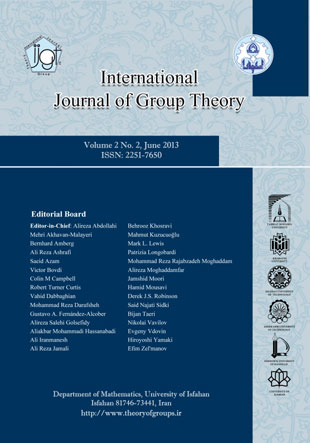فهرست مطالب

International Journal of Group Theory
Volume:2 Issue: 2, Jun 2013
- تاریخ انتشار: 1391/07/23
- تعداد عناوین: 7
-
-
صفحات 1-8تعداد تجزیه های یک گروه آبلی متناهی به صورت حاصلضرب دو زیرگروه، به دو روش مختلف محاسبه و یک اتحاد ترکیبیاتی که متضمن ضرایب دو جمله ای گاوسی، نمایش داده شده است.
-
صفحات 9-17هالاس، ماروتی، سیدکی و بزرا ثابت کرده اند که یک گروه باسط مزدوجی است اگر و فقط اگر حاصلضرب مستقیم گروه های ساده یا آبلی که باسط مزدوجی هستند، باشد.
نیز دارای جزء تحویل ناپذیر باشد. در این مقاله، قدم های اولیه برای تعیین گروه های باسط سرشتی را بر می داریم.
-
صفحات 35-39
-
Pages 1-8The number of factorizations of a finite abelian group as the product of two subgroups is computed in two different ways and a combinatorial identity involving Gaussian binomial coefficients is presented.Keywords: Factorization numberý, ýAbelian groupý, ýsubgroupý, ýGaussianý ýbinomial coefficient
-
Pages 9-17We say that a finite group $G$ is conjugacy expansive if for any normal subset $S$ and any conjugacy class $C$ of $G$ the normal set $SC$ consists of at least as many conjugacy classes of $G$ as $S$ does. Halasi، Mar''oti، Sidki، Bezerra have shown that a group is conjugacy expansive if and only if it is a direct product of conjugacy expansive simple or abelian groups. By considering a character analogue of the above، we say that a finite group $G$ is character expansive if for any complex character $alpha$ and irreducible character $chi$ of $G$ thecharacter $alpha chi$ has at least as many irreducible constituents، counting without multiplicity، as $alpha$ does. In this paper we take some initial steps in determining character expansive groups.Keywords: finite group, Irreducible characters, product of characters
-
Pages 19-24Let $G$ be a finite group and let $N$ be a normal subgroup of $G$. Suppose that $ {rm{Irr}} (G | N) $ is the set of the irreducible characters of $G$ that contain $N$ in their kernels. In this paper، we classify solvable groups $G$ in which the set $mathcal {C} (G) = {{rm{Irr}} (G | N) | 1 ne N trianglelefteq G}$ has at most three elements. We also compute the set $mathcal {C} (G) $ for such groups.Keywords: Irreducible characters, Conjugacy classes, minimal normal subgroups, Frobenius groups
-
Pages 25-33In this paper we present some results about subgroup which is generalization of the subgroup $R_ {2} ^ {otimes} (G) = {ain G| [a،g] otimes g=1_{otimes}، forall gin G}$ of right $2_ {otimes} $-Engel elements of a given group $G$. If $p$ is an odd prime، then with the help of these results، we obtain the results about tensor squares of p-groups satisfying the law $ [x،g،y] otimes g=1_ {otimes} $، for all $x، g، yin G$. In particular p-groups satisfying the law $ [x،g،y] otimes g=1_ {otimes} $ have abelian tensor squares. Moreover، we can determine tensor squares of two-generator p-groups of class three satisfying the law $ [x،g،y] otimes g=1_ {otimes} $.Keywords: Non_abelian tensor square_Engel elements of a group_p_groups
-
Pages 35-39Let $G$ be a finite group. We denote $psi (G) =sum_ {gin G} o (g) $ where $o (g) $ denotes the order of $g in G$. Here we show that $psi (A_5) < psi (G) $ for every nonsimple group $G$ of order 60. Also we prove that $psi (PSL(2،7))groups $G$ of order 168. These two results confirm the conjecture posed in [2] for simple groups $A_5$ and $PSL (2،7) $.Keywords: finite groups, simple group, element orders
-
Pages 41-45Three infinite families of finite abeliab groups will be described such that each members of these families has the Redei k-property for many non-trivial values of k.Keywords: Factoring abelian groups, periodic subsets, full, rank subsets, Hajos k, property, Redei k, property
-
Pages 47-72The non-commuting graph $nabla(G)$ of a non-abelian group $G$ is defined as follows: its vertex set is $G-Z(G)$ and two distinct vertices $x$ and $y$ are joined by an edge if and only if the commutator of $x$ and $y$ is not the identity. In this paper we ''ll prove that if $G$ is a finite group with $nabla(G)congnabla(BS_{n})$, then $G cong BS_{n}$, where $BS_{n}$ is the symmetric group of degree $n$, where $n$ is a natural number.Keywords: non, commuting graph, symmetric group, Finite groups

